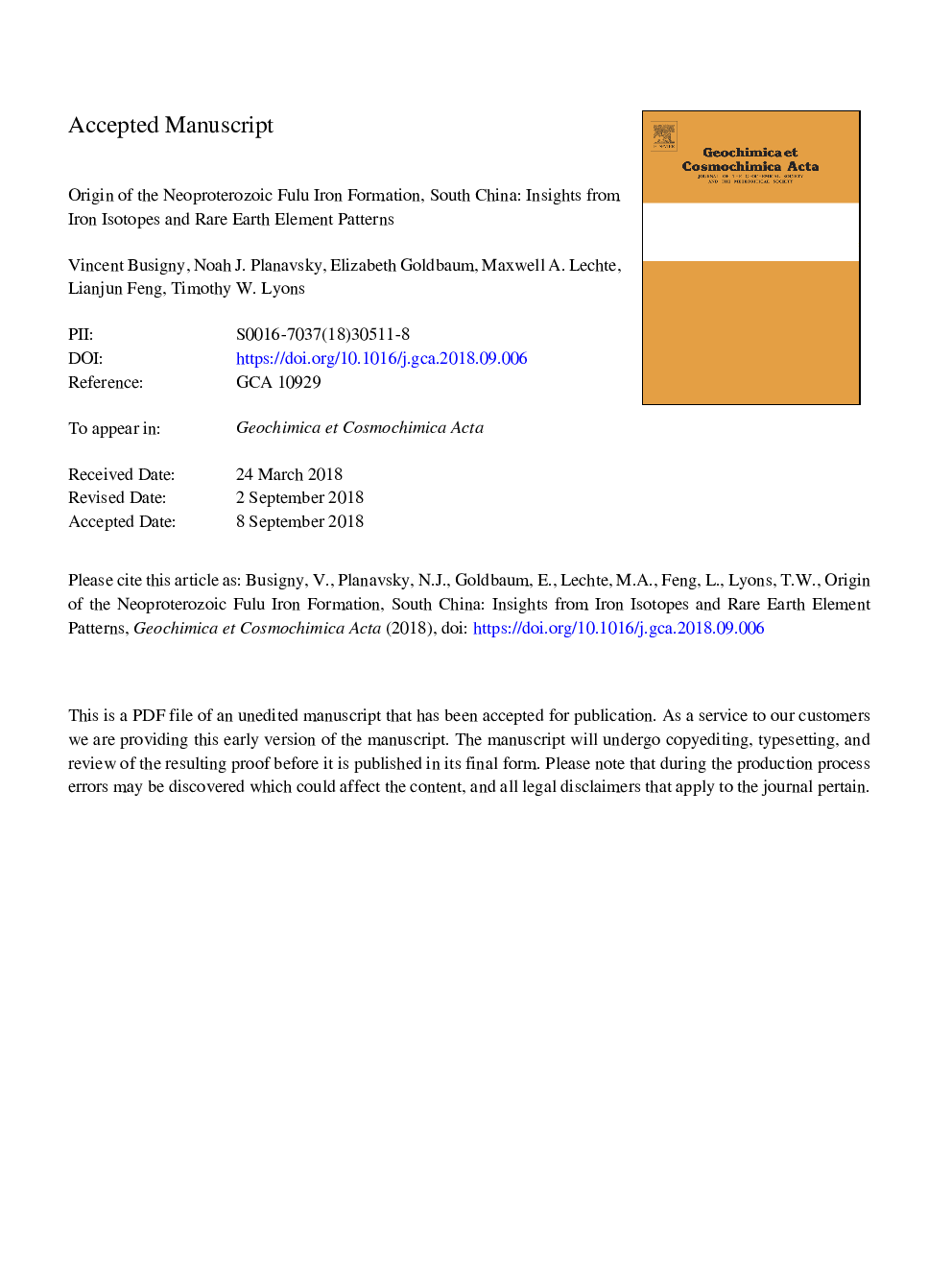| کد مقاله | کد نشریه | سال انتشار | مقاله انگلیسی | نسخه تمام متن |
|---|---|---|---|---|
| 11024660 | 1701097 | 2018 | 49 صفحه PDF | دانلود رایگان |
عنوان انگلیسی مقاله ISI
Origin of the Neoproterozoic Fulu iron formation, South China: Insights from iron isotopes and rare earth element patterns
دانلود مقاله + سفارش ترجمه
دانلود مقاله ISI انگلیسی
رایگان برای ایرانیان
کلمات کلیدی
موضوعات مرتبط
مهندسی و علوم پایه
علوم زمین و سیارات
ژئوشیمی و پترولوژی
پیش نمایش صفحه اول مقاله

چکیده انگلیسی
In the Neoproterozoic Era there was widespread deposition of iron formations in close association with global or near glaciations. These 'Snowball Earth' glaciations likely played a key role in iron formation distribution and deposition. However, the environmental conditions, Fe sources, and formation mechanisms remain debated. Here we present the rare earth element geochemistry and Fe isotope composition of the synglacial iron formation within the Neoproterozoic Fulu Formation, South China. The Fulu iron formation consists of layers of authigenic minerals (mainly hematite) and detrital components (quartz, feldspars, Fe chlorite, and minor biotite). Positive Eu anomalies in one of the Fulu localities indicate a hydrothermal influence, suggesting that Fe was mainly sourced from distal hydrothermal systems. The bulk-rock Fe isotope composition of the Fulu iron formation shows a large range, with δ56Fe from â0.23 to +1.78â°. Correlation between bulk-rock δ56Fe values and Al/Fe ratios demonstrates that δ56Fe variability reflects, in part, varying proportions of authigenic versus detrital components. The Fe isotope composition of authigenic hematite is calculated by a linear regression and shows δ56Fe between +0.83 and +2.21â°, with an average at +1.54â¯Â±â¯0.50â° (2Ï, nâ¯=â¯41). Using a dispersion-reaction model, the high δ56Fe values of hematite constrain local dissolved O2 concentrations of the ocean to less than 0.4â¯nmol/L, even in the shallow part of the water column. This relationship is consistent with highly reducing conditions in the Neoproterozoic oceans favored by isolation from the atmosphere by a sea ice. We attribute the extremely positive values to partial iron oxidation in waters that were cold relative to modern surface oceans. The dominant occurrence of hematite supports an abiotic precipitation pathway, given that biological activity would have introduced organic matter to the sediments and led to partial reduction of Fe(III) oxides and subsequent formation of magnetite and/or siderite, as is observed in Archean and Paleoproterozoic iron formations. Oxic glacial meltwater and/or O2 vertical transfer from the atmosphere to the upper ocean linked to ice dynamics is likely to have mediated the abiotic oxidation. We propose that vertical transfer of O2 resulted from the deposition of snow that trapped air bubbles at the top of the glacier coupled to a melting of the bottom of the glacier, which in combination delivered a limited but continuous amount of O2 to the ocean.
ناشر
Database: Elsevier - ScienceDirect (ساینس دایرکت)
Journal: Geochimica et Cosmochimica Acta - Volume 242, 1 December 2018, Pages 123-142
Journal: Geochimica et Cosmochimica Acta - Volume 242, 1 December 2018, Pages 123-142
نویسندگان
Vincent Busigny, Noah J. Planavsky, Elizabeth Goldbaum, Maxwell A. Lechte, Lianjun Feng, Timothy W. Lyons,